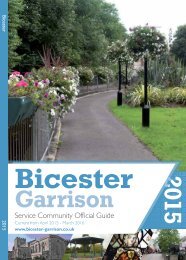Shrivenham 2015
Annual guide for serving personnel and their families in the Shrivenham station detailing Local Amenities, Housing, Education & Leisure activities in the area.
Annual guide for serving personnel and their families in the Shrivenham station detailing Local Amenities, Housing, Education & Leisure activities in the area.
Create successful ePaper yourself
Turn your PDF publications into a flip-book with our unique Google optimized e-Paper software.
The History of <strong>Shrivenham</strong> Station<br />
The Domesday Book of 1086 records the Manor of Becote as being held by William Count<br />
of Evreux. William held the manor on behalf of the King, and it is believed that King John was in<br />
residence in 1204.<br />
Later the family of Beckett held the Manor upon the duty of making the fires in the Royal<br />
Bedchamber. When the lands were extended in the reign of Edward III the duties were changed to<br />
include the presentation to the King of two white capons whenever he should cross “Fowyeare’s Mill<br />
Bridge’’. This bridge is most probably the culvert inside the gates by the north lodge.<br />
In 1633 the Manor was bought by Sir Henry Marten, a judge. During his son’s tenancy in the Civil War<br />
the house was partly destroyed by fire. On the death of his son, the lands were sold first to Sir George<br />
Pratt of Coleshill, and in 1666 to John Wildman. Wildman’s son adopted John Shute as his heir and when<br />
in 1716, Shute succeeded to the Barrington estates, he changed his name accordingly and established<br />
Beckett as the family seat. It remained the property of the Barringtons until the estate was bought by the<br />
War Department in 1936.<br />
There has been a house on the present site since the Conquest, but the previous building stood to the north<br />
of the present one which was built between 1831 and 1834. William Atkinson, its architect, was the son of a<br />
Durham miner. He became the protégé of the Bishop Shute Barrington, and after study in London he became<br />
Architect to the Board of Ordnance. Apart from minor alterations, including the removal of a large conservatory<br />
at the back of the house, the property remains in much the same state as it did in the nineteenth century.<br />
The familiar red brick buildings were erected between 1936 and 1939, and during the war Beckett House played<br />
its part alongside these more functional blocks in housing a variety of occupiers. Units which were stationed at<br />
<strong>Shrivenham</strong> included 131 and 132 AA Batteries, 133 OCTU(RA), a School of Anti Aircraft Defence, a US Army<br />
Officers’ Candidate School, Schools for Signals, Police, Cooks, Bakers, Clerks, and the Civil Affairs Centre (AMGOT).<br />
In June 1946 the <strong>Shrivenham</strong> American University was established here, and this is recorded on a tablet in the Billiard<br />
Room. On 9 October 1946 the 1st Technical Staff Officers course assembled at <strong>Shrivenham</strong> and Beckett House became<br />
one of the Halls of the then Military College of Science. Since then it was temporarily converted to house the college<br />
library. However, in 2005 the library was moved to its new location in the old College Hall (as Barrington Library) and<br />
Beckett House has now been completed a significant refurbishment to become part of the Defence Academy.<br />
The Station<br />
Page 5



